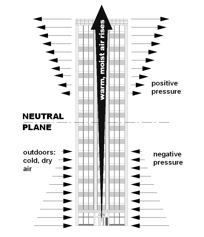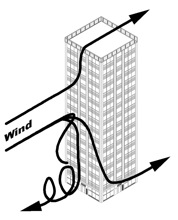The building envelope includes all building components that separate the building interior from the outdoor environment. This normally includes the walls, the roof, and the basement or first floor slab.
Sources of Moisture in Walls
Moisture infiltrates the building envelope as water vapor through air leakage, in liquid form through openings and by capillary action across permeable materials. Moisture can be propelled by differences in air or vapor pressure, by gravity, and/or by wind.
In tall buildings, the chimney or “stack” effect creates high air and vapor pressure in the interior of the upper part of the building and low pressure in the lower part. Interior air warmed and humidified by human bodies, mechanical equipment, lighting and solar heat gain rises to the top of the building. This pushes warm air and moisture outward at the top of the building and draws cooler exterior air in at the bottom. Additionally, high winds can force moisture into walls. This is known as wind driven rain. Near the tops of buildings, high winds can even drive moisture upward along the wall.
Air and moisture move from hot, humid areas to cold, dry areas. Condensation will occur on cool surfaces that come into contact with hot, humid air. Depending upon your geographic location and whether it is summer or winter, will dictate if the moisture movement is from interior to exterior or exterior to interior.
Stack Effect and Pressure Differences
Pressure differences between the building interior and exterior tend to force air and moisture into the walls. This can result in rot, corrosion, masonry and concrete spalling, and lowered energy efficiency. Stack effect is one source of pressure differences.
Stack effect occurs because warm, moist air is less dense than cold, dry air. The warm air rises and creates outward pressure at the tops of tall buildings and inward pressure at the bottoms.
See Figure 1.
At the point between the positive pressure at the top of the building and the negative pressure near the bottom is a neutral plane. Ignoring the effects of wind, if a window is opened above the neutral plane, air flows from the interior of the building to the exterior. Conversely, if a window is opened below the neutral plane, air will travel from the exterior to the interior. This is one reason why tall buildings typically have revolving doors. Due to the significant negative pressure on the lower level, it can be physically difficult to open a standard hinged exterior door.
Another reason for revolving doors and for fixed windows in tall buildings is to prevent uncontrolled air movement through the building. Uncontrolled air movement can affect the operation of the mechanical systems and cause excessive pressure across the air barrier system.
Considering the stack effect and the resulting air and moisture movement, designers may actually manipulate the position of the neutral plane to work in their favor.
For example, if you are in a cold climate, the main concern is to prevent warm humid air from passing from the interior to the exterior and potentially condensing in the exterior wall assembly. Thus, it would be advantageous to move the neutral plane up as high as possible. That way, if there is air movement occurring through the exterior wall, it will be from the exterior to the interior. One way to move the neutral plane up is to have a greater amount of exhaust ventilation relative to fresh-air make-up. This will put the building under slightly negative pressure.
The opposite is true for a climate that is predominately hot and humid. A phenomena known as reverse stack effect will occur due to the air conditioning on the inside and hot, humid weather on the exterior. Air inside the building will tend to fall, causing negative pressure at the top of the building and positive pressure at the bottom. Air leakage would preferably be from the interior to the exterior, as the dry air is inside and the humid air is outside. Thus we want the neutral plane to be as high as possible. Having more fresh-air make-up relative to exhaust ventilation will help to accomplish this. There is of course an implication of increased energy costs associated with the use of mechanical equipment to try and control the neutral plane location.
Stack effect and mechanical pressurization are not the only sources of pressure differential. Wind, barometric pressure, and thermal cycling can also cause pressure differences that promote air movement through walls and may cause moisture to be trapped inside the wall assembly. Wind causes positive pressure on the side of the building it impacts and suction on the other three sides and the roof. This will tend to draw air in on the windward side and expel interior air on the other sides. The barometric pressure of the exterior environment will vary according to the weather and will have different effects on the building envelope according to the local micro climate.
Wind Driven Rain
In most areas, wind driven rain comes predominantly from one direction. In many areas of North America, the prevailing wind is from the west. However, if there is a change in weather bringing rain, a change in wind direction may occur. Mountains, large bodies of water, and other landscape features may influence wind patterns and influence when precipitation occurs and where. Building condition assessors should be aware of the prevailing wind direction and wind driven rain direction in their area.
We expect the side of the building receiving most of the wind driven rain to be the highly susceptible to wear and deterioration. This is particularly true if there are below freezing temperatures, as the freezing moisture will expand, causing additional damage to the cladding system, sealants, etc.
The wind speeds affecting taller buildings or buildings located in large open areas can be significant. High wind speeds create a greater force to push moisture into the wall assembly. Rainwater can actually travel sideways or upward, especially near the top of buildings. See Figure 2. These extreme conditions must be considered when reviewing the cladding systems.
By Richard Weldon – P.Eng, LEED AP

